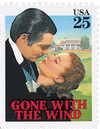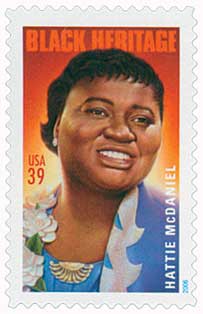
# 2446 - 1990 25c Classic Films: Gone With the Wind
US #2446
1990 Gone With the Wind
- Part of a Set of 4 Classic Films stamps
- Commemorates 50th anniversary of four Oscar-nominated films
- Celebrates the Golden Age of Hollywood
Stamp Category: Commemorative
Set: Classic Films
Value: 25¢, First-Class mail rate
First Day of Issue: March 23 1990
First Day City: Hollywood, California
Quantity Issued: 44,202,000
Printed by: American Bank Note Company
Printing Method: Photogravure
Format: Panes of 40, from printing cylinders of 160
Perforations: 11
Why the stamp was issued: This stamp is part of a block of four honoring classic films from Hollywood’s golden era. Each of the four films featured received Academy Award nominations in 1940.
About the stamp design: Each stamp resembles a miniature movie poster with bright, glossy colors. They picture the stars of each film, as well as the title and a scene from the movie in the background. Thomas Blackshear was chosen to do the artwork for the stamps. He used original movie posters and photographs from the films as inspiration.
First Day City: The First Day of Issue ceremony for the Classic Movie stamps took place at the Academy of Motion Pictures Arts and Sciences in Beverly Hills, California, though the postmark was Hollywood. This was the location of the 62nd Academy Awards celebration three days later.
Unusual fact about these stamps: The stamps were originally planned for issue in 1989, the 50th anniversary of release of these films. Difficulties with obtaining permission from the film company and families of the stars pictured delayed the stamps until 1990. This coincided with the Academy Awards ceremony for these films.
About the Set: Time magazine called 1939 the “year of genius and glitter” that was “the most memorable 12 months in the history of the American cinema.” All the films featured in this set were produced that year, and all were nominated for Academy Awards (or Oscars). The four movies chosen for the stamps were: The Wizard of Oz, Gone with the Wind, Beau Geste, and Stagecoach.
History the stamp represents:
The film Gone with the Wind adapted the 1936 novel by Margaret Mitchell. Set in the south during the Civil War, it tells the struggles of Scarlett O’Hara, the daughter of a Georgia plantation owner. The film was popular from it original release and remains the highest-grossing film in history (adjusted for inflation). Gone with the Wind was awarded ten Academy Awards including Best Picture, Best Actress (Vivien Leigh), and Best Supporting Actress (Hattie McDaniel). McDaniel was the first African American to win an Academy Award.
Hattie McDaniel’s Academy Award Win
McDaniel, the youngest child of former slaves, was born in Wichita, Kansas, and raised in Denver, Colorado. She dropped out of high school to tour with vaudeville companies. When McDaniel arrived in Hollywood in 1931, she supported herself by working on radio and washing clothes.
McDaniel was in her 30s before her career really began. She had performed, written, and recorded songs before the Great Depression, but the downturn in the economy halted her singing aspirations. Her brother got her a gig on his radio show as a maid who often “forgets her place.” Her character, “Hi-Hat-Hattie,” was a hit. (McDaniel later became known for her many comedic roles as a bossy, opinionated maid.)
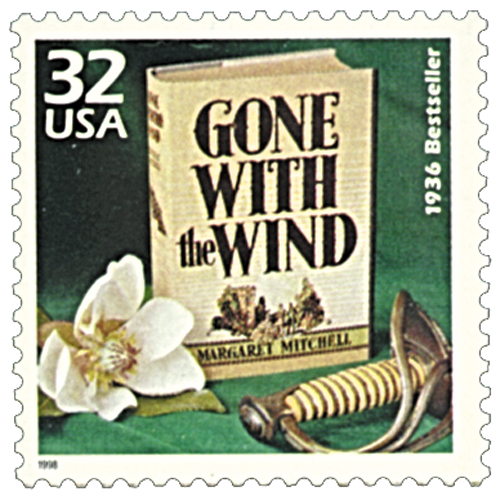
McDaniel soon began appearing in films – as many as 300 – including roles as extras, maids, and chorus singers. Due to the scarcity of roles for African-American actresses, McDaniel spent much of her 20-year career playing maids. She has been quoted as saying, “I’d rather play a maid than be one.”
Increased recognition and membership in the Screen Actors Guild got McDaniel into movies, though usually in “bit” parts. Her big break came in 1934 when she was cast in a lead role in John Ford’s Judge Priest, starring Will Rogers. The roles poured in from there.
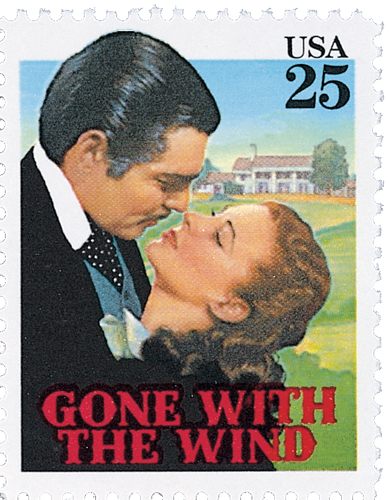
By the late 1930s, Hollywood was abuzz with the film adaptation of Margaret Mitchell’s Gone with the Wind. The competition for the part of the maid Mammy was said to be nearly as stiff as that for lead role, Scarlett O’Hara. Among the competition was First Lady Eleanor Roosevelt’s own maid, Elizabeth McDuffie. Though she’d come to be known as a comic actress and doubted she’d get the part, McDaniel decided to audition anyway. Some say Clark Gable recommended her for the role, which she ultimately landed.
The film premiered on December 15, 1939, at the Loew’s Grand Theater in Atlanta, Georgia. At the time, segregation was still in full force in the state and violence against African Americans was rampant. With this in mind, the studio asked McDaniel and other African American cast members not to attend the premiere. Her co-star Clark Gable threatened to boycott the premiere unless she was allowed to attend. But she convinced him to go anyway.
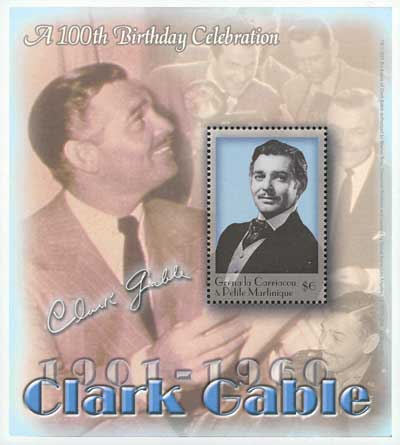
Gone with the Wind was immensely popular – it was the highest-earning film up to that time. It received 13 Academy Award nominations, winning 10 on February 29, 1940. Among those was McDaniel’s award for Best Supporting Actress. She was the first African American in history to win an Oscar. In her acceptance speech she said, “This is one of the happiest moments of my life, and I want to thank each one of you who had a part in selecting me for one of their awards, for your kindness. It has made me feel very, very humble; and I shall always hold it as a beacon for anything that I may be able to do in the future. I sincerely hope I shall always be a credit to my race and to the motion picture industry. My heart is too full to tell you just how I feel, and may I say thank you and God bless you.”
US #2446
1990 Gone With the Wind
- Part of a Set of 4 Classic Films stamps
- Commemorates 50th anniversary of four Oscar-nominated films
- Celebrates the Golden Age of Hollywood
Stamp Category: Commemorative
Set: Classic Films
Value: 25¢, First-Class mail rate
First Day of Issue: March 23 1990
First Day City: Hollywood, California
Quantity Issued: 44,202,000
Printed by: American Bank Note Company
Printing Method: Photogravure
Format: Panes of 40, from printing cylinders of 160
Perforations: 11
Why the stamp was issued: This stamp is part of a block of four honoring classic films from Hollywood’s golden era. Each of the four films featured received Academy Award nominations in 1940.
About the stamp design: Each stamp resembles a miniature movie poster with bright, glossy colors. They picture the stars of each film, as well as the title and a scene from the movie in the background. Thomas Blackshear was chosen to do the artwork for the stamps. He used original movie posters and photographs from the films as inspiration.
First Day City: The First Day of Issue ceremony for the Classic Movie stamps took place at the Academy of Motion Pictures Arts and Sciences in Beverly Hills, California, though the postmark was Hollywood. This was the location of the 62nd Academy Awards celebration three days later.
Unusual fact about these stamps: The stamps were originally planned for issue in 1989, the 50th anniversary of release of these films. Difficulties with obtaining permission from the film company and families of the stars pictured delayed the stamps until 1990. This coincided with the Academy Awards ceremony for these films.
About the Set: Time magazine called 1939 the “year of genius and glitter” that was “the most memorable 12 months in the history of the American cinema.” All the films featured in this set were produced that year, and all were nominated for Academy Awards (or Oscars). The four movies chosen for the stamps were: The Wizard of Oz, Gone with the Wind, Beau Geste, and Stagecoach.
History the stamp represents:
The film Gone with the Wind adapted the 1936 novel by Margaret Mitchell. Set in the south during the Civil War, it tells the struggles of Scarlett O’Hara, the daughter of a Georgia plantation owner. The film was popular from it original release and remains the highest-grossing film in history (adjusted for inflation). Gone with the Wind was awarded ten Academy Awards including Best Picture, Best Actress (Vivien Leigh), and Best Supporting Actress (Hattie McDaniel). McDaniel was the first African American to win an Academy Award.
Hattie McDaniel’s Academy Award Win
McDaniel, the youngest child of former slaves, was born in Wichita, Kansas, and raised in Denver, Colorado. She dropped out of high school to tour with vaudeville companies. When McDaniel arrived in Hollywood in 1931, she supported herself by working on radio and washing clothes.
McDaniel was in her 30s before her career really began. She had performed, written, and recorded songs before the Great Depression, but the downturn in the economy halted her singing aspirations. Her brother got her a gig on his radio show as a maid who often “forgets her place.” Her character, “Hi-Hat-Hattie,” was a hit. (McDaniel later became known for her many comedic roles as a bossy, opinionated maid.)

McDaniel soon began appearing in films – as many as 300 – including roles as extras, maids, and chorus singers. Due to the scarcity of roles for African-American actresses, McDaniel spent much of her 20-year career playing maids. She has been quoted as saying, “I’d rather play a maid than be one.”
Increased recognition and membership in the Screen Actors Guild got McDaniel into movies, though usually in “bit” parts. Her big break came in 1934 when she was cast in a lead role in John Ford’s Judge Priest, starring Will Rogers. The roles poured in from there.

By the late 1930s, Hollywood was abuzz with the film adaptation of Margaret Mitchell’s Gone with the Wind. The competition for the part of the maid Mammy was said to be nearly as stiff as that for lead role, Scarlett O’Hara. Among the competition was First Lady Eleanor Roosevelt’s own maid, Elizabeth McDuffie. Though she’d come to be known as a comic actress and doubted she’d get the part, McDaniel decided to audition anyway. Some say Clark Gable recommended her for the role, which she ultimately landed.
The film premiered on December 15, 1939, at the Loew’s Grand Theater in Atlanta, Georgia. At the time, segregation was still in full force in the state and violence against African Americans was rampant. With this in mind, the studio asked McDaniel and other African American cast members not to attend the premiere. Her co-star Clark Gable threatened to boycott the premiere unless she was allowed to attend. But she convinced him to go anyway.

Gone with the Wind was immensely popular – it was the highest-earning film up to that time. It received 13 Academy Award nominations, winning 10 on February 29, 1940. Among those was McDaniel’s award for Best Supporting Actress. She was the first African American in history to win an Oscar. In her acceptance speech she said, “This is one of the happiest moments of my life, and I want to thank each one of you who had a part in selecting me for one of their awards, for your kindness. It has made me feel very, very humble; and I shall always hold it as a beacon for anything that I may be able to do in the future. I sincerely hope I shall always be a credit to my race and to the motion picture industry. My heart is too full to tell you just how I feel, and may I say thank you and God bless you.”





